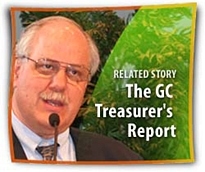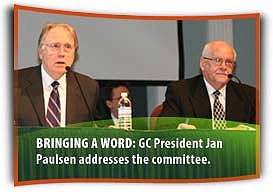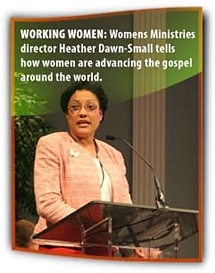
Tell the World
GC vice presidents Michael L. Ryan, Lowell C. Cooper, and Mark A. Finley led a two-hour presentation on the world church’s evangelistic initiative Tell the World, whose primary mission is to provide a way for every person in the world to hear the gospel message within the next five years. Describing the Adventist Church as being “not a bureaucratic institution involved in administrative trivia but [an organization] focused on mission—its evangelistic mission,” Finley reminded attendees of the church’s continual growth since its beginning in the mid-nineteenth century.
 About 3,500 members worshipped in a few dozen churches in North America in 1863, and today the Adventist Church comprises more than 14 million church members worldwide, Finley reported. He also presented world ratios ranging from one Adventist to every 373,143 people in the world in 1863, to one for every 1,268 in 1980, to one for every 430 in 2006.
About 3,500 members worshipped in a few dozen churches in North America in 1863, and today the Adventist Church comprises more than 14 million church members worldwide, Finley reported. He also presented world ratios ranging from one Adventist to every 373,143 people in the world in 1863, to one for every 1,268 in 1980, to one for every 430 in 2006.
Finley added that it took the church 107 years, from 1848-1955, to grow to 1 million members; 14.7 years, 1955-1970, to reach the 2 million mark; and 3.3 years, 1983-1986, to hit 5 million. Since 1986, the church has grown by a million members every 12 to 18 months, he said.
“Tell the World is making an impact today of huge proportions for Christ and the kingdom of God,” Finley said.
Division Reports
Leaders from several of the church’s world divisions gave reports and multimedia presentations depicting Tell the World initiatives in their regions.
Euro-Africa Division secretary Gabriel E. Maurer described multiple outreach ministries using radio, television, printed publications, and the Internet in countries such as Austria, Italy, Czechia, Switzerland, and Romania.
 Artur A. Stele, president of Euro-Asia Division, said almost 12,000 satellite sites received the satellite downlinks from Kiev during a recent evangelistic series, resulting in 3,068 people baptized. He added that a new church Internet site had some 4 million hits in just two months.
Artur A. Stele, president of Euro-Asia Division, said almost 12,000 satellite sites received the satellite downlinks from Kiev during a recent evangelistic series, resulting in 3,068 people baptized. He added that a new church Internet site had some 4 million hits in just two months.
Paul S. Ratsara, president of Southern Africa-Indian Ocean Division (SID), said his division is targeting Johannesburg, South Africa—with a population of about 3.2 million—for evangelism. The church leaders’ focus is training lay members to become soul winners. “The people are on fire for God,” Ratsara said.
Following Ratsara’s presentation, Finley added that in one SID pastoral district, 273 members scattered in a few small churches were empowered for evangelism through prayer and training. They began holding evangelistic meetings, and 3,000 people were baptized by the end of the first series. Two-and-a-half years later, the district membership has grown to 21,000.
In the Trans-European Division, which comprises regions as diverse as Iceland, Egypt, Denmark, Iraq, and the United Kingdom, president Bertil A. Wiklander shared the division’s goals of planting 350 new churches, developing 1,500 small groups, and conducting 3,000 public evangelistic meetings, with one of every 10 conducted by youth.
“Public evangelism can still work in Europe,” Wiklander said, “but it is not the only method we use.” He then described “innovative community outreach” organized mainly by youth and young adults using small-group evangelism and church-planting initiatives.
Wiklander added that 120 people in war-torn Darfur in western Sudan were recently baptized.
Northern Asia-Pacific Division president Jairyong Lee described his region’s goal to increase member involvement with the community by setting up vegetarian restaurants and health clinics, providing meals to the elderly, and organizing prison ministries, child care services, and stop-smoking seminars. The division is also establishing English-speaking churches throughout its territory as an evangelistic outreach.
GC Initiative Updates  GC department directors also reported on new world initiatives and advancements in technology.
GC department directors also reported on new world initiatives and advancements in technology.
Benjamin D. Schoun, president of Adventist World Radio (AWR) and coordinator of the Tell the World initiative for media, informed executive committee members that AWR is adding new languages to its programs in Africa and Asia. The broadcasting organization has also presented the AWR Signal Award to North West and North East Nigeria conferences in recognition of their progressive outreach to Muslims living in their regions, using AWR as the primary outreach tool.
The GC Communication Department now has a podcast of news that averages 350 hits a day, Schoun said. And Adventist News Network has about 6,000 regular subscribers and an additional 7,000 hits a day from nonsubscribers.
The worldwide publishing work is also alive and well. Schoun reported that literature evangelists have sold more than 12 million copies of books and magazines, and church members have distributed 14 million missionary books and given away free 5 million copies of church magazines during the last year.
The Southern Africa-Indian Ocean and the Euro-Africa divisions have opened two new media centers in their regions to assist in the Hope Channel television outreach. Hope Channel is opening a new channel for Romanian broadcasts, and also is working toward opening another channel for China by August 2007.
“This is a major development,” Schoun said.
GC Women’s Ministries director Heather-Dawn Small affirmed that women worldwide are committed to improving the quality of life for women and sharing the love of Jesus by focusing on issues such as literacy, abuse, poverty, and women’s workloads.
“Women’s Ministries believes we need to touch people in their area of greatest need,” Small said.
Closing the Back Door
Executive Committee members on Tuesday of the session voted to adopt an appeal from the GC Council on Evangelism and Witness to church leaders and members to curb membership loss.
Presented by GC vice presidents Lowell C. Cooper and Mark A. Finley, the Council’s two-and-a-half-page statement indicated that although more than 5 million people were baptized into the Adventist Church from 2000 to 2005, nearly 1.4 million members walked out the back door and left the church.
During the last quinquennium some divisions began a review of active membership, Cooper said, resulting in higher-than-usual membership loss ratios.
“Current indications are that annual membership losses, for reasons other than death, equal approximately 28 percent of membership accessions,” and this “is not limited to new members,” the statement read.
The document cited research suggesting social and relational factors play a much larger role in a person’s dissatisfaction with the church rather than disagreement with church doctrine.
“The reasons more frequently cited by persons who leave local church fellowship are found in the realm of relationships, the absence of a sense of belonging, and the lack of meaningful engagement in the local congregation and its mission,” it read. “Therefore, the loss of members for these reasons should be preventable.”
The statement suggests that new members will most likely remain in the church if they are able to articulate their beliefs, form friendships within the congregation, and engage in ministry—in other words, “know a sense of belonging and identity.” To accomplish this, local church boards should, among other things, review membership care strategies, study membership accession and loss patterns, repeat Bible instruction, develop friendships and small groups with new members, and encourage new members to become involved in church outreach and other activities.
Executive Committee members who spoke to this issue were unanimous in their support of the appeal; however, some questioned how greater attention for member retention can be made part of the culture at the local church level. Suggestions by some participants included establishing an accountability process for local leaders, board members aggressively focusing on designing a discipling-oriented church, and cultivating a spirit of true love and concern for others.
“We have to have in our heart a love for people,” Paulsen said. “More than anything else . . . this will help us to retain our members.”
Nominating Committee Report
The Executive Committee elected three people recommended by the nominating committee to serve in GC positions:

|
Juan R. Prestol
, NAD treasurer, was elected as the new General Conference undertreasurer, succeeding Steven G. Rose, who has accepted a call to serve as vice president of Financial Administration for Walla Walla College. Rose was GC undertreasurer for more than eight years.A native of the Dominican Republic, Prestol has served as NAD treasurer for nine years. He has also worked as treasurer of the Euro-Asia Division, the Atlantic Union Conference, the Greater New York Conference, and the North Dominican Conference.
"It’s a humbling experience to be given the opportunity to work with the division treasurers and other church leaders across the world field,” Prestol told the Adventist Review. “This opens the door for new service, and it’s with this spirit that I accept the election.”

|
Paul H. Douglas
, an associate director of GC Auditing Service (GCAS) who was based in the Inter-American Division in Miami, was elected director of the church's worldwide auditing agency, headquartered at the General Conference. Born in Jamaica, Douglas has 20 years auditing experience, serving both in North America and Inter-America. He succeeds Eric A. Korff, who retired after 14 years as director.Spring Meeting News Notes: